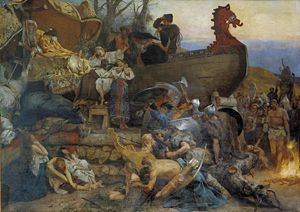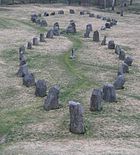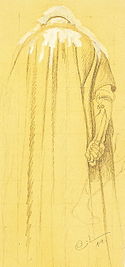- Norse funeral
-
Burial customs of Viking Age Norsemen (early medieval Scandinavians) are known both from archaeology and from historical accounts such as the Icelandic sagas, Old Norse poetry, and notably from the account of Ahmad ibn Fadlan.
Throughout Scandinavia, there are many remaining tumuli in honour of Viking kings and chieftains, in addition to runestones and other memorials. Some of the most notable of them are at the Borre mound cemetery, in Norway, and Lindholm Høje and Jelling in Denmark.
A prominent tradition is that of the ship burial, where the deceased was laid in a boat, or a stone ship, and given grave offerings in accordance with his earthly status and profession, sometimes including sacrificed slaves. Afterwards, piles of stone and soil were usually laid on top of the remains in order to create a tumulus.
Contents
Grave goods
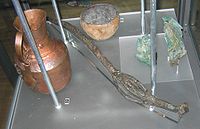 Grave goods from a Völva's grave in Köpingsvik, Öland. There is an 82 cm long wand of iron with bronze details and a unique model of a house on the top. The finds are on display in the Swedish Museum of National Antiquities in Stockholm.
Grave goods from a Völva's grave in Köpingsvik, Öland. There is an 82 cm long wand of iron with bronze details and a unique model of a house on the top. The finds are on display in the Swedish Museum of National Antiquities in Stockholm.
It was common to leave gifts with the deceased. Both men and women received grave goods, even if the corpse was to be burnt on a pyre. The amount and the value of the goods depended on which social group the dead person came from.[1] It was important to bury the dead in the right way so that he could join the afterlife with the same social standing that he had had in life, and to avoid becoming a homeless soul that wandered eternally.[2]
The usual grave for a thrall was probably not much more than a hole in the ground.[1] He was probably buried in such a way as to ensure both that he did not return to haunt his masters and that he could be of use to his masters after they died. Slaves were sometimes sacrificed to be useful in the next life.[2] A free man was usually given weapons and equipment for riding. An artisan, such as a blacksmith, could receive his entire set of tools. Women were provided with their jewelry and often with tools for female and household activities. The most sumptuous Viking funeral discovered so far is the Oseberg ship burial, which was for a woman (probably a queen or a priestess) who lived in the 9th century.[1][3]
Funerary monuments
A Viking funeral could be a considerable expense, but the barrow and the grave goods were not considered to have been wasted. In addition to being a homage to the deceased, the barrow remained as a monument to the social position of the descendants. Especially powerful Norse clans could demonstrate their position through monumental grave fields. The Borre mound cemetery in Vestfold is for instance connected to the Yngling dynasty, and it had large tumuli that contained stone ships.[3]
Jelling, in Denmark, is the largest royal memorial from the Viking Age and it was made by Harald Bluetooth in memory of his parents Gorm and Tyra, and in honour of himself. It was only one of the two large tumuli that contained a chamber tomb, but both barrows, the church and the two Jelling stones testify to how important it was to mark death ritually during the pagan era and the earliest Christian times.[3]
On three locations in Scandinavia, there are large grave fields that were used by an entire community: Birka in Mälaren, Hedeby at Schleswig and Lindholm Høje at Ålborg.[3] The graves at Lindholm Høje show a large variation in both shape and size. There are stone ships and there is a mix of graves that are triangular, quadrangular and circular. Such grave fields have been used during many generations and belong to village like settlements.[4]
Rituals
Death has always been a critical moment for those bereaved, and consequently death is surrounded by taboo-like rules.[4] Family life has to be reorganized and in order to master such transitions, people use rites.[4] The ceremonies are transitional rites that are intended to give the deceased peace in his or her new situation at the same time as they provide strength for the bereaved to carry on with their lives.[4]
Despite the warlike customs of the Vikings, there was an element of fear surrounding death and what belonged to it. If the deceased was not buried and provided for properly, he might not find peace in the afterlife. The dead person could then visit the bereaved as a revenant or draugr. Such a sight was frightful and ominous and usually it was interpreted as a sign that additional family members would die. It was first and foremost in times of starvation, when communities were struck with a series of misfortunes, that rumours about revenants began to flourish. The sagas tell of drastic precautions being taken after a revenant had appeared. The dead person had to die anew; a stake could be put through the corpse, or its head might be cut off in order to stop the deceased from finding its way back to the living.[5]
Other rituals involved the preparation of the corpse. Snorri Sturluson in the Prose Edda references a concern funeral rite involving the cutting of nails[6] lest unpared nails from the dead be available for the completion of the construction of Naglfar, the ship used to transport the army of jötunn at Ragnarök.[7]
Ibn Fadlan's account
A 10th century Arab Muslim writer named Ahmad ibn Fadlan produced a description of a funeral of a Scandinavian,[8] probably Swedish,[9] chieftain who was on an expedition on the eastern route.[9] The account is a unique source on the ceremonies surrounding the Viking funeral,[9][10] of a chieftain.[10]
The dead chieftain was put in a temporary grave which was covered for ten days until they had sewn new clothes for him. One of his thrall women volunteered to join him in the afterlife and she was guarded day and night, being given a great amount of intoxicating drinks while she sang happily. When the time had arrived for cremation, they pulled his longship ashore and put it on a platform of wood, and they made a bed for the dead chieftain on the ship. Thereafter, an old woman referred to as the "Angel of Death" put cushions on the bed. She was responsible for the ritual.[11]
Then they disinterred the chieftain and gave him new clothes. In his grave, he received intoxicating drinks, fruits and a stringed instrument. The chieftain was put into his bed with all his weapons and grave offerings around him. Then they had two horses run themselves sweaty, cut them to pieces, and threw the meat into the ship. Finally, they sacrificed a hen and a cock.[11]
Meanwhile, the thrall girl went from one tent to the other and had sexual intercourse with the men. Every man told her "tell your master that I did this because of my love to him". While in the afternoon, they moved the thrall girl to something that looked like a door frame, where she was lifted on the palms of the men three times. Every time, the girl told of what she saw. The first time, she saw her father and mother, the second time, she saw all her relatives, and the third time she saw her master in the afterworld. There, it was green and beautiful and together with him, she saw men and young boys. She saw that her master beckoned for her.[11] By using intoxicating drinks, they thought to put the thrall girl in an ecstatic trance that made her psychic and through the symbolic action with the door frame, she would then see into the realm of the dead.[10] The same ritual also appears in the Icelandic short story Völsa þáttr where two pagan Norwegian men lift the lady of the household over a door frame to help her look into the otherworld.[12]
Thereafter, the thrall girl was taken away to the ship. She removed her bracelets and gave them to the old woman. Thereafter she removed her finger rings and gave them to the old woman's daughters, who had guarded her. Then they took her aboard the ship, but they did not allow her to enter the tent where the dead chieftain lay. The girl received several vessels of intoxicating drinks and she sang and bade her friends farewell.[13]
Then the girl was pulled into the tent and the men started to beat on the shields so her screams could not be heard. Six men entered into the tent to have intercourse with the girl, after which they put her onto her master's bed. Two men grabbed her hands, and two men her wrists. The angel of death put a rope around her neck and while two men pulled the rope, the old woman stabbed the girl between her ribs with a knife. Thereafter, the relatives of the dead chieftain arrived with a burning torch and set the ship aflame.[13] It is said that the fire facilitates the voyage to the realm of the dead, but unfortunately, the account does not tell to which realm the deceased was to go.[10]
Afterwards, a round barrow was built over the ashes and in the centre of the mound they erected a staff of birch wood, where they carved the names of the dead chieftain and his king. Then they departed in their ships.[13]
Human sacrifice
Thralls could be sacrificed during a funeral so that they could serve their master in the next world.[2] In Ibn Fadlan's account above, there is a description of a slave girl who was to be sacrificed and who had to undergo several sexual rites.[8] When the chieftain had been put in the ship, she went from tent to tent where she visited warriors and traders.[8] Every man told her that they did what they did for their love to the dead chieftain.[8] Lastly, she entered a tent that had been raised on the ship, and in it six men had intercourse with her before she was strangled and stabbed.[8] The sexual rites with the slave girl show that she was considered to be a vessel for the transmission of life force to the deceased chieftain.[14]
Sigurðarkviða hin skamma contains several stanzas in which the Valkyrie Brynhildr gives instructions for the number of slaves that were to be sacrificed for the funeral of the hero Sigurd, and how their bodies were to be arranged on the pyre, as in the following stanza:
- Því at hánum fylgja
- fimm ambáttir,
- átta þjónar,
- eðlum góðir,
- fóstrman mitt
- ok faðerni,
- þat er Buðli gaf
- barni sínu.[15]
Cremation
It was common to burn the corpse and the grave offerings on a pyre, in which the temperature reached 1,400 degrees Celsius—much higher than modern crematorium furnaces attain. All that would remain was some incinerated fragments of metal and some animal and human bones. The pyre was constructed so that the pillar of smoke would be as massive as possible in order to elevate the deceased to the afterlife.[17] The symbolism is described in the Ynglinga saga:[18]
"Thus he (Odin) established by law that all dead men should be burned, and their belongings laid with them upon the pile, and the ashes be cast into the sea or buried in the earth. Thus, said he, every one will come to Valhalla with the riches he had with him upon the pile; and he would also enjoy whatever he himself had buried in the earth. For men of consequence a mound should be raised to their memory, and for all other warriors who had been distinguished for manhood a standing stone; which custom remained long after Odin's time."Funeral ale and the passing of inheritance
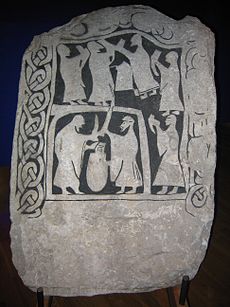 A drinking scene on an image stone from Gotland, in the Swedish Museum of National Antiquities in Stockholm.
A drinking scene on an image stone from Gotland, in the Swedish Museum of National Antiquities in Stockholm.
On the seventh day after the person had died, people celebrated the sjaund, or the funeral ale that the feast also was called since it involved a ritual drinking. The funeral ale was a way of socially demarcating the case of death. It was only after the funeral ale that the heirs could rightfully claim their inheritance.[4] If the deceased was a widow or the master of the homestead, the rightful heir could assume the high seat and thereby mark the shift in authority.[5]
Several of the large runestones in Scandinavia notify of an inheritance,[5] such as the Hillersjö stone which explains how a lady came to inherit not only her children but also her grandchildren[19] and the Högby Runestone, which tells that a girl was the sole heir after the death of all her uncles.[20] They are important proprietary documents from a time when legal decisions were not yet put to paper. One interpretation of the Tune Runestone from Østfold suggests that the long runic inscription deals with the funeral ale in honour of the master of a household and that it declares three daughters to be the rightful heirs. It is dated to the 5th century and it is consequently the oldest legal document from Scandinavia that talks of female right to inheritance.[5]
See also
References
Citations
- ^ a b c Steinsland & Meulengracht 1998, p. 84.
- ^ a b c Friberg 2000, B. Gräslund, "Gamla Uppsala During the Migration Period", p. 11.
- ^ a b c d Steinsland & Meulengracht 1998, p. 85.
- ^ a b c d e Steinsland & Meulengracht 1998, p. 86.
- ^ a b c d Steinsland & Meulengracht 1998, p. 87.
- ^ Krappe 2003, pp. 327–328.
- ^ Anderson 2006, Snorri Sturluson, "The Younger Edda, Also Called Snorre's Edda, or the Prose Edda", pp. 417-418.
- ^ a b c d e Harrison & Svensson 2007, p. 79.
- ^ a b c Steinsland & Meulengracht 1998, p. 88.
- ^ a b c d Steinsland & Meulengracht 1998, p. 90.
- ^ a b c Steinsland & Meulengracht 1998, p. 88.
- ^ Harrison & Svensson 2007, p. 57ff.
- ^ a b c Steinsland & Meulengracht 1998, p. 88ff.
- ^ Steinsland & Meulengracht 1998, p. 89.
- ^ Sigurðarkviða in skamma
- ^ Bellows 1936, p. 441.
- ^ Friberg 2000, B. Gräslund, "Gamla Uppsala During the Migration Period", p. 12.
- ^ "The Ynglinga Saga". The Online Medieval and Classical Library. http://omacl.org/Heimskringla/ynglinga.html.
- ^ Harrison & Svensson 2007, p. 178.
- ^ Larsson 2002, p. 141.
Sources
- Anderson, Rasmus Björn (2006). Norse Mythology Or the Religion of Our Forefathers: Containing All the Myths of the Eddas. Chicago: Kessinger Publishing. ISBN 142864184X. http://books.google.com/books?id=Ju9-9jM58qAC.
- Bellows, Henry Adams (1936). The Poetic Edda. Princeton University Press. http://books.google.com/books?id=0NqzAAAAIAAJ.
- Friberg, Gunnel (2000). Myth, Might, and Man. Riksantikvarieämbetets Förl. ISBN 9172091908. http://books.google.com/books?id=0CHzNAAACAAJ.
- Harrison, Dick; Svensson, Kristina (2007). Vikingaliv. Natur och Kultur. ISBN 9127357252. http://books.google.com/books?id=wAchMwAACAAJ.
- Krappe, Alexander Haggerty (2003). Science of Folklore. Kessinger Publishing. ISBN 0766158136. http://books.google.com/books?id=yLxnfMHY2ywC.
- Larsson, Mats G. (2002). Götarnas Riken: Upptäcktsfärder Till Sveriges Enande. Atlantis. ISBN 9174866419. http://books.google.com/books?id=euvdNQAACAAJ.
- Steinsland, Gro; Meulengracht, Sørensen Preben (1998). Människor och makter i vikingarnas värld. Ordfront. ISBN 9173245917. http://books.google.com/books?id=1atUAAAACAAJ.
Further reading
- Magoun, Francis Peabody; Bessinger, Jess B.; Creed, Robert P. (1965). "Ibn Fadlan's Account of the Rus with Some Commentary and Some Allusions to Beowulf (H. M. Smyser, pp. 92-119)". Franciplegius: Medieval and Linguistic Studies in Honor of Francis Peabody Magoun. New York: New York University Press. http://books.google.com/books?id=x4hyQgAACAAJ.
- Richards, Julian D.; Beswick, Pauline; Bond, Julie; Jecock, Marcus; McKinley, Jacqueline; Rowland, Stephen; Worley, Fay (2004). "Excavations at the Viking Barrow Cemetery at Heath Wood, Ingleby, Derbyshire". The Antiquaries Journal 84: 23–116. http://eprints.whiterose.ac.uk/635/1/richardsjd1.pdf.
External links
Categories:- Death customs
- Viking practices
- Viking Age
- Ship burials
Wikimedia Foundation. 2010.

